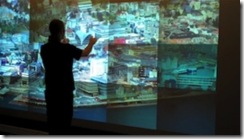Gesture control adds a third dimension to the multitouch concept
While multi-touch technologies are currently on the verge of conquering the mainstream market via smartphones and tablets, researchers are already working on the revolutionary evolution of the technology. In the future, computers, notebooks and smartphones will be operated contactlessly using gesture control in front of the respective device or screen. This is made possible by light-sensitive LCD pixels, cameras or electrical voltage fields.
{jumi [plugins/content/jumi/newsgrafik.php]}
Control without touch
"Contactless control without a mouse and keyboard opens up completely new possibilities for interacting with computers. My idea is to lean back on the couch and operate the computer, the networked television or even the tablet with a few intuitive gestures without the device or having to touch the screen, "explains Daniel Stødle from the Computer Science Institute at the Norwegian University of Tromsø in an interview with pressetext.
Stødle has developed an innovative control system with which huge screen projections can be controlled using gestures. As is known from current multi-touch concepts, content can be opened, zoomed and rearranged using two hands or multiple fingers. The difference, however, is that the control takes place via gestures in the air, which are recorded by cameras on the ground and translated into computer language.
Wall display with 22 megapixels
A total of 22 cameras are used for the 16-megapixel wall display used at the university, which is six meters wide. The cameras connected to a computer network create, through their arrangement and lens alignment, a virtual interaction surface in front of the screen, which can be used to operate applications. In a current experiment, Google Earth serves as an illustrative example.
Both the cameras used and the computer processors that are used to convert the gestures into computer commands are conventional, not particularly powerful hardware. "Another advantage of the system is that the multiple cameras also enable three-dimensional interaction for the first time," explains Stødle. For example, the system can be used to perform a 3D scan of real objects. The Norwegian researcher described the minimum number of cameras required as at least three.
LCD pixels as sensors
US researchers at the MIT Media Laboratory in Cambridge, on the other hand, are pursuing a different, but no less exciting, approach. As the technology portal Allvoices reports, the scientists are working on the development of new types of LCD pixels that not only emit light, but can also receive it. "In this way, you convert a display into a mega-pixel sensor that can interpret gestures," says Professor Ramesh Rakar from MIT. In hospitals or other public places, such a technology reduces the risk of coming into contact with pathogens.
(ck)
.


